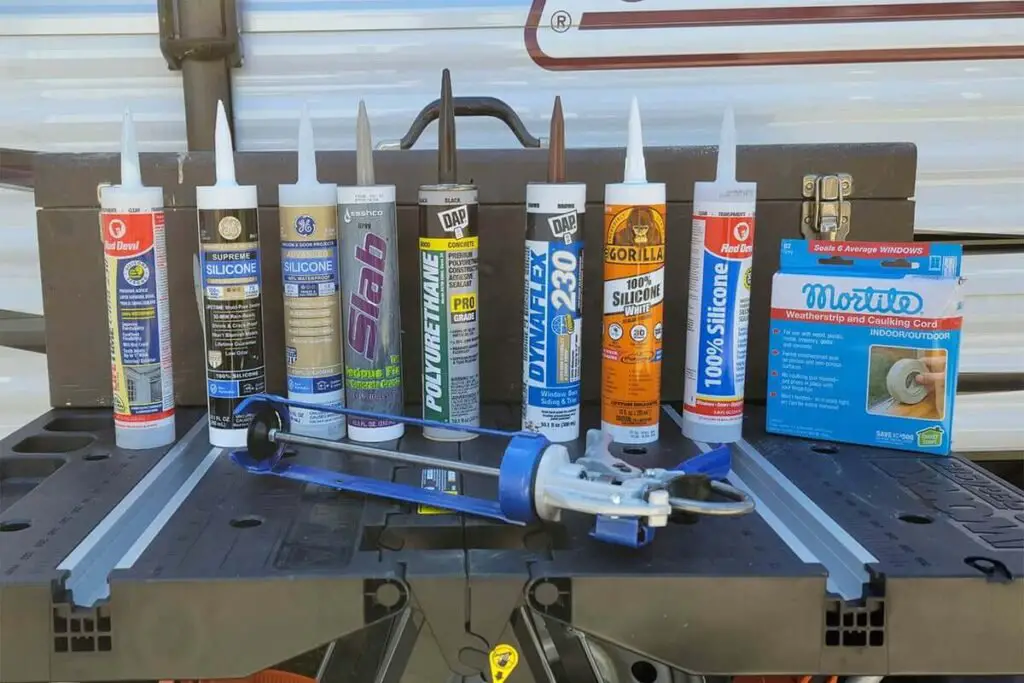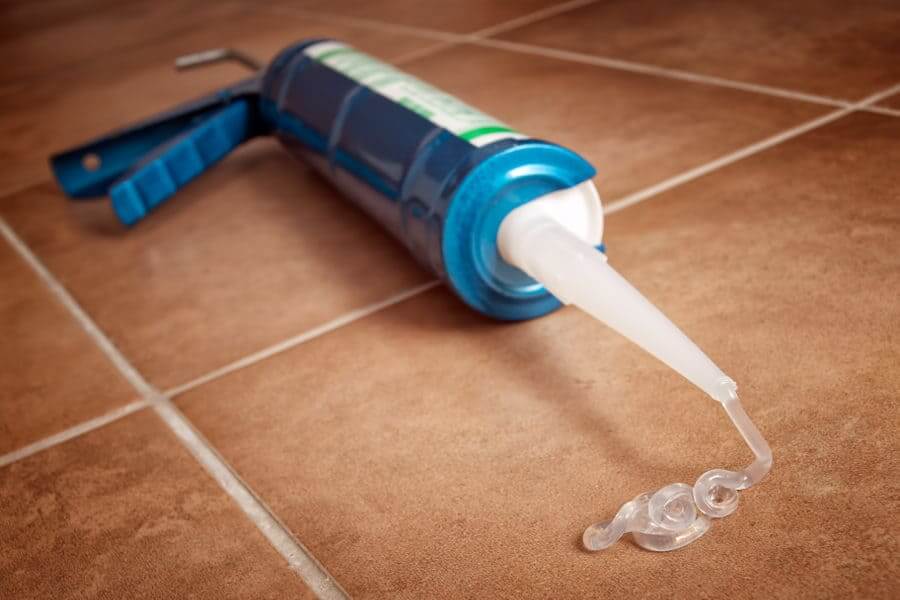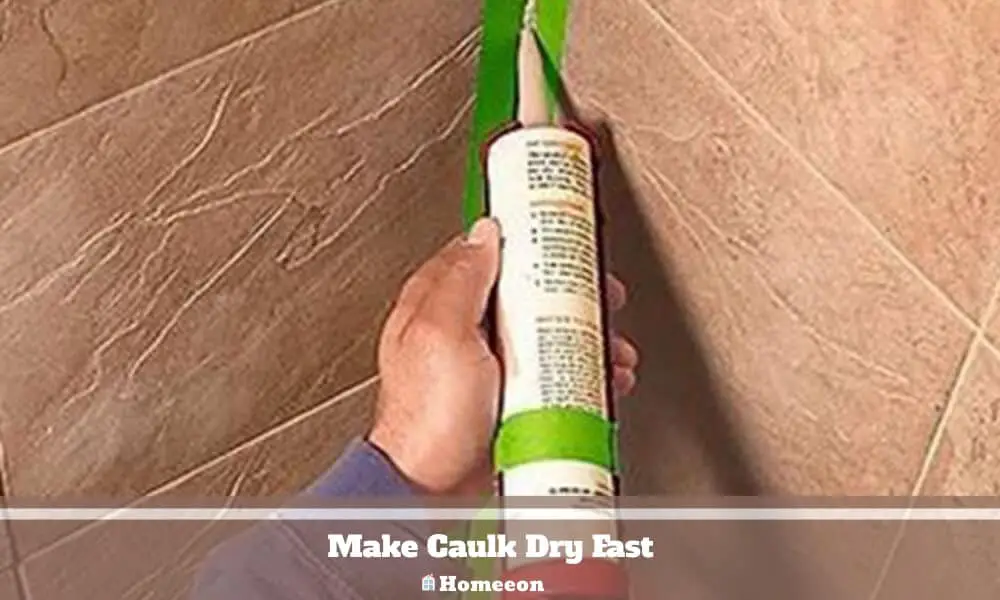Last Updated on August 9, 2023 By Emma W. Thomas
To make caulk dry faster, follow these steps:
- Ensure proper ventilation and low humidity.
- Use a fan or dehumidifier.
- Choose fast-drying caulk formulas.
- Apply thin layers.
- Use a hair dryer on low heat or a heat gun on low settings, maintaining caution.
- Be patient for the best results.
How To Make Caulk Dry Fast
1. Optimal Temperature Requirement:
Caulking material dries quickly when applied in an environment with a temperature between 40-80°F (4-26°C). Regulate the temperature of the area where the caulk is applied to speed up the drying process.
2. Apply Thin Layers:
Rather than applying a hefty amount of caulk, it is best to apply thin layers. This allows the air to access more surface area of the material, thus enabling it to dry faster.
3. Use Quick-Dry Caulk:
There are fast-drying caulk options available in the market designed to dry quickly. These types of caulk are most suitable when the project is on a time crunch.
4. Proper Ventilation:
Provide adequate ventilation to the area where the caulk has been applied. The circulation of air speeds up the drying process.
5. Use a Hairdryer or Heat Gun:
For small caulk projects, a hair dryer or heat gun can be employed to speed up the drying process. Hold the hairdryer or heat gun a safe distance away from the caulk to avoid damaging it but close enough for the heat to have an effect.
6. Use a Dehumidifier:
In a humid environment, it can take a longer time for the caulk to dry. Using a dehumidifier can reduce the moisture content in the air, helping the caulk to dry faster.
7. Let the Caulk Cure Properly:
Even if the caulk appears dry on the surface, it may still be wet underneath. Try not to disturb it and allow the caulk to cure fully. This also strengthens the caulk and extends its lifespan.
How Long Does It Take For Caulk To Dry?

Acrylic latex and silicone caulk can take up to 30 minutes of air exposure to dry. But the drying time will depend on how well-ventilated or humid your space is. However, the time taken can take between one to ten days, depending on the formula used for the caulk to cure or fully set and for it to become completely ready for use or waterproof.
If you want your caulk to dry well within the correct length of time, use the right caulk for the task. For glass, ceramic, or metal use silicone caulk. This substance adheres easily to nonporous, smooth surfaces and creates a flexible but durable bond. You can get silicone caulk with microbial additives, perfect for eradicating germs in bathrooms and kitchens.
If you need to fill small gaps and joints in wood in areas that are not exposed to a lot of water, you can use acrylic latex caulk. This substance can also be used in the regions that are to be painted. Acrylic latex caulk can crack or shrink over time and leave the surface open to water damage. There are acrylic latex caulks with silicone additives that help improve durability and flexibility, and make them more waterproof. This property makes the caulk suitable for use in sinks and tubs.
For window seals and outdoor uses, polyurethane-based caulk is ideal. This caulk is paintable and produces great elasticity. It also creates a watertight seal and repels dirt, and it, however, takes much more time to cure than both latex and silicone caulk.
How To Choose The Caulk To Use
It would be best to choose the right caulk type to use for different jobs to achieve the best results. Some silicone caulk may be labeled as fast-drying, but there is a need to read the fine print before using it. You will want to know the ideal drying conditions for humidity and temperatures. You need to allow at least 3-12 hours for drying and 24-hours to cure. Latex-based products need 24-hours before exposure to water, while polyurethane requires up to 10 days to cure.
| Type Of Caulk | Time Needed To Cure |
| Silicone | 2-12 hours to dry, 24-hours to cure |
| Latex-based | 24-hours before exposure to water |
| Polyurethane | Up to 10-hours to cure |
Check If The Caulk Is Paintable
If you plan to paint over caulk, look for one that will continue to cure beneath the paint coat. For example, if you intend to separate a tiled backlash from a painted wall or mold tile in your bathroom. You can paint after 30 minutes for silicone and acrylic latex caulk, but you will have to wait for 7-10 days before you can paint for polyurethane. Ensure that you read the manufacturer’s instructions since the products have a different application and drying formula.
Understand The Reaction Of Your Formula With Moisture
Acrylic latex-based caulk will dry as water evaporates from it, and placing a fan in the room speeds up the drying process. On the other hand, silicone caulk requires moisture to cure and dry, and you need to place a humidifier to dry it. If you are using polyurethane caulk, do not expose it to direct water or extra moisture for three to seven days.
Effect Of Temperature On How Caulk Dries
Caulk needs a temperature of between 40 and 80 degrees Fahrenheit to dry. Be sure to regulate your thermostat accordingly. Silicone may take longer to cure during winter; never increase the heat to speed up the process. If you do this, the silicone might melt as the heat softens.
Latex will freeze in extremely cold weather, while frigid air does not have enough moisture to cure polyurethane properly. Ensure that you avoid freezing temperatures when drying caulk.
Use Fresh Caulk For Better Results
Avoid older latex and silicone caulks since they will deteriorate in quality even if they are in a sealed pipe. Old caulks may also not cure fully; it is necessary to check for the expiry date on the label before using. If the tube has no date indicated, you can test a strip of it on a solid surface to see if it forms a firm coat within 30 minutes.
Make sure that you use polyurethane caulk within 12 months of manufacturing.
What Happens If Caulk Gets Wet Before Curing?

If caulk becomes wet before curing, then the moisture won’t evaporate fast. When water takes time to disappear, this can also take a lot of time to dry up, and may also be difficult getting proper adhesion. Excess moisture can also cause mold and mildew to grow.
Caulk cures faster in a well-aired and dry environment. If you let moisture settle on the caulk before it dries completely, it will get spoilt. The following are the effects of water getting on caulking before it cures:
Delay Of Curing Process
Moisture prolongs the curing process for water-based caulk. This substance dries better and fast in airy and dry surroundings. Different manufacturers provide instructions about suitable temperatures and humidity. However, these levels vary in other places and will impact the time taken for caulk to cure.
Excess Moisture May Lead To The Splitting Of Caulk
If you leave a caulking tube in the rain or water, it can split open under pressure. You can prevent this splitting by wrapping duct tape around the pipe. Alternatively, prevent moisture from coming into contact with caulk.
Water Hinders Bonding
If your surface has peeling paint, mold, dirt, rust, old caulk, or moisture, it prevents caulk from bonding. It will not bond into a cohesive sealant and cause the caulk to fall off and not stick to the surface.
Ensure that you first clean the surface and wipe it to get rid of excess moisture before applying the caulking.
Moisture Causes Mildew And Mold
Wet caulk may get mildew and mold. If moisture gets on a fresh caulk that hasn’t cured accurately, it will damage it. The purpose of caulking is to seal off a place from germs, insects, and dirt, but moisture will change into mildew and mold.
Running Water Causes Uncured Caulk To Break And Wash Out
A wet surface does not achieve proper adhesion and may prevent caulk from curing. Avoid applying caulk if it is likely to rain within 24-hours. But if it is crucial to apply caulking despite snow and rain forecasts, then cover the surface with a plastic tarp. Doing this helps to protect caulk from moisture, thus preventing cracking or wash out.
Humidity Affects The Curing Time
The time taken for caulking to cure is also affected by humidity levels. A home that has high humidity levels cures faster than one with low levels. However, some products, such as silicone-based caulk in the market, can cure and dry quickly. These products also endure moisture in the surroundings.
Conclusion
The caulk curing process continues after it is applied on the surface. You need to consider the number of hours taken for caulk to dry according to the instructions given. It is also necessary to think about the weather, humidity, and temperature to get a practical time frame for caulk to dry and cure.
References:
https://www.bobvila.com/articles/how-long-does-caulk-take-to-dry/
https://www.hunker.com/13402706/how-to-speed-up-caulk-drying
Emma is a graduate of Domestic Science or Family and Consumer Sciences (Home Economics) from the University of Wisconsin. She has 7 years of experience Working with the strategic section of BestBuy and now writing full-time for Homeeon.
From Managing the Home, Interiors, Cleaning, and Exteriors to Gardening and everything about Making A Home Liveable – is her passion and this Homeeon is the result of this.
Emma loves decorating her home with the best stuff found online. She cares about quality over anything and writes reviews about them here in Homeeon. Get in touch with her over Pinterest.
Keep reading her blogs.

